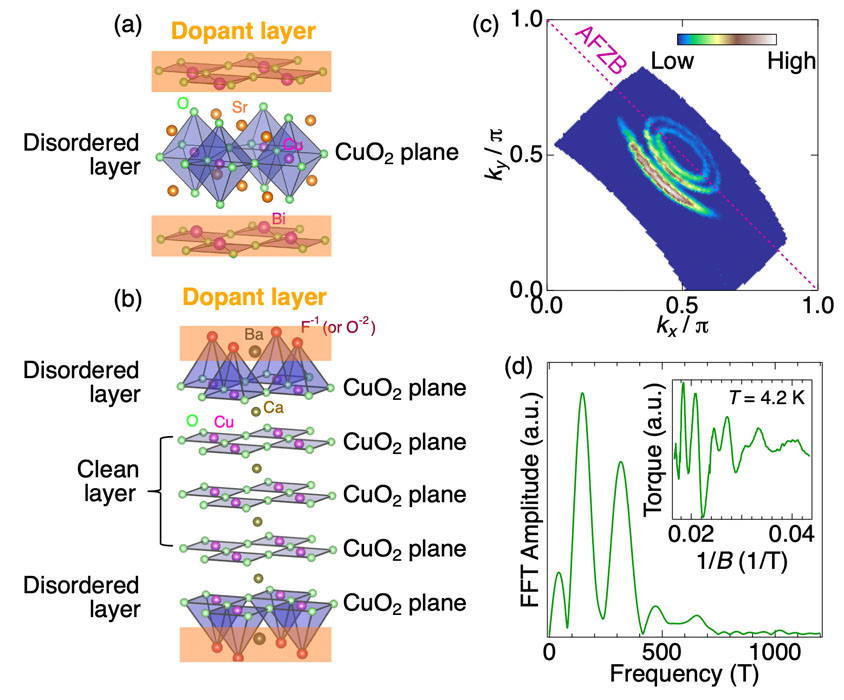Observation of Small Fermi Pockets in a Copper Oxide High-Tc Superconductor
Kondo and Kohama Groups
High-temperature superconductivity is one of the most significant discoveries in physics in the latter half of the 20th century. Since the discovery of high-temperature superconductivity in 1986, their physical properties have been intensively studied from various aspects. However, a unified understanding of the mechanism for high-temperature superconductivity has not yet been established. The most basic and important issue relevant to it is the relationship between antiferromagnetic state forming Mott insulator and high-temperature superconductivity induced by carrier doping. In this study, we focused on a multi-layered cuprate high-Tc superconductor (Fig. 1b) with a clean superconducting plane (CuO2 layer) that is structurally flat and has charges uniformly distributed along the plane. Here we perform laser-based angle-resolved photoelectron spectroscopy (ARPES) with high energy resolution and quantum oscillation measurement at a strong magnetic field and present the first observation of small Fermi pockets formed in the close vicinity of the Mott insulating phase. Furthermore, we find the coexistence of antiferromagnetism and high-temperature superconductivity in the same CuO2 sheet.

Fig. 1. (a) Crystal structure of single-layer cuprate superconductor (Bi2Sr2CuO6+δ is presented as an example). (b) Crystal structure of 5-layer cuprate superconductor, Ba2Ca4Cu5O10(F,O)2, we have focused on in this study. (c) Fermi surfaces of Ba2Ca4Cu5O10(F,O)2 observed by laser-ARPES. (d) Quantum oscillation measurements for the same compound.
Superconductivity of cuprate superconductors occurs via carrier doping to the CuO2 layers from the dopant layers sandwiching them. The main target in previous studies was for structurally simple compounds with one or two CuO2 planes per unit cell (Fig. 1a). While these have the advantage to be easy in synthesizing, it has been pointed out that the direct contact of the dopant layers to the superconducting layers causes structural distortion and non-uniform charge distribution along the CuO2 plane, leading to disordered electronic states. To solve this problem, we selected a multilayer system with five CuO2 planes per unit cell, Ba2Ca4Cu5O10(F,O)2, for a study (Fig. 1b).
This compound has inner CuO2 planes that can avoid direct contact to the dopant layers. These inner CuO2 planes are structurally flat, and at the same time, protected by the outer CuO2 plane from the dopant layers causing the effects of spatially non-uniform carrier doping and defects. Therefore, this multilayered system gives us an excellent opportunity to study an extremely clean superconducting layer that is close to the ideal case treated in theoretical studies.
By performing high-resolution laser-ARPES and quantum oscillation measurements for the clean superconducting layers (Fig. 1c), we successfully observed small Fermi pockets, which had been theoretically expected yet elusive for more than 30 years of research for cuprates. The spectra of Fermi pockets are much sharper in energy than that of Fermi arc, indicating that the pockets we observed indeed come from the inner CuO2 plane protected from the random potential induced by dopant layers. Moreover, we have confirmed the existence of d-wave superconducting gap around the Fermi pockets, providing spectroscopic evidence for the coexistence between antiferromagnetism and superconductivity in the same CuO2 sheet.
Our results are expected to facilitate the experimental and theoretical research pursuing the mechanism of high-temperature superconductivity in cuprates. In particular, these will contribute to solving the long-standing puzzle of the Fermi arc phenomena and urge the need for revisiting the Mott physics leading to the electron pairing in cuprates, which, up to now, has been based mainly on the research on single- and double-layered compounds with inhomogeneous electronic states.
References
- [1] S. Kunisada et al., Science 369, 833 (2020).
